External links
| Meteorite... | |||||||||||||||||||||||
|---|---|---|---|---|---|---|---|---|---|---|---|---|---|---|---|---|---|---|---|---|---|---|---|
| Classification |
| ||||||||||||||||||||||
| Mineralogy and petrology |
| ||||||||||||||||||||||
| Lists |
| ||||||||||||||||||||||
| Mineo | |
|---|---|
| Type | Stony-iron |
| Class | Pallasite |
| Group | Main Group Pallasite |
| Country | Italy |
| Region | Sicily |
| Coordinates | 37°17′N14°42′E / 37.283°N 14.700°E [1] |
| Observed fall | Yes |
| Fall date | 3 May 1826 |
| TKW | 42 g |
Mineo was one of the only four witnessed fall pallasite meteorites in the world, and the only one from Italy.
On 3 May 1826 a bright meteor was observed over Sicily. Near the small town of Mineo (CT) was seen the fall of an object, followed by a loud sound. From the small crater was recovered a metallic mass.
Only 42g from this fall are still preserved in collections.

A meteorite is a rock that originated in outer space and has fallen to the surface of a planet or moon. When the original object enters the atmosphere, various factors such as friction, pressure, and chemical interactions with the atmospheric gases cause it to heat up and radiate energy. It then becomes a meteor and forms a fireball, also known as a shooting star; astronomers call the brightest examples "bolides". Once it settles on the larger body's surface, the meteor becomes a meteorite. Meteorites vary greatly in size. For geologists, a bolide is a meteorite large enough to create an impact crater.

A lunar meteorite is a meteorite that is known to have originated on the Moon. A meteorite hitting the Moon is normally classified as a transient lunar phenomenon.

The Cape York meteorite, also known as the Innaanganeq meteorite, is one of the largest known iron meteorites, classified as a medium octahedrite in chemical group IIIAB. In addition to many small fragments, at least eight large fragments with a total mass of 58 tonnes have been recovered, the largest weighing 31 tonnes. The meteorite was named after Cape York, a prominent geographic feature located approximately 30 miles (48 km) west of the east coast of Meteorite island and the nearby peninsulas in northern Melville Bay, Greenland, where the first meteorite fragments were discovered.

The pallasites are a class of stony–iron meteorite. They are relatively rare, and can be distinguished by the presence of large olivine crystal inclusions in the ferro-nickel matrix.
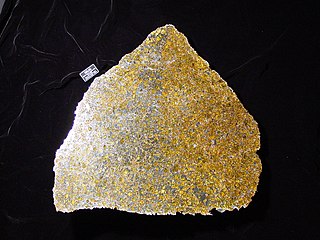
Imilac is a pallasite meteorite found in the Atacama Desert of Northern Chile in 1822.

Mesosiderites are a class of stony–iron meteorites consisting of about equal parts of metallic nickel-iron and silicate. They are breccias with an irregular texture; silicates and metal occur often in lumps or pebbles as well as in fine-grained intergrowths. The silicate part contains olivine, pyroxenes, and Ca-rich feldspar and is similar in composition to eucrites and diogenites.

A meteorite fall, also called an observed fall, is a meteorite collected after its fall from outer space was observed by people or automated devices. Any other meteorite is called a "find". There are more than 1,300 documented falls listed in widely used databases, most of which have specimens in modern collections. As of February 2023, the Meteoritical Bulletin Database had 1372 confirmed falls.
Meteorite fall statistics are frequently used by planetary scientists to approximate the true flux of meteorites on Earth. Meteorite falls are those meteorites that are collected soon after being witnessed to fall, whereas meteorite finds are discovered at a later time. Although there are 30 times as much finds than falls, their raw distribution of types does not accurately reflect what falls to Earth. The reasons for this include the following:
Omolon is a meteorite fallen in 1981 in the Omolon River basin, Magadan (Russia). It is a pallasite.

Gao–Guenie is a H5 ordinary chondrite meteorite that fell on Burkina Faso, West Africa, on March 5, 1960. The fall was composed of many fragments and it is one of the largest observed meteorite showers in Africa to date.

Pallasovka is a pallasite meteorite found in 1990 near the town of Pallasovka, Russia.

Mbosi is an ungrouped iron meteorite found in Tanzania. It is one of the world's largest meteorites, variously estimated as the fourth-largest to the eighth-largest, it is located near the city of Mbeya in Tanzania's southern highlands. The meteorite is 3 metres (9.8 ft) long, 1 metre high, and weighs an estimated 16 metric tons.
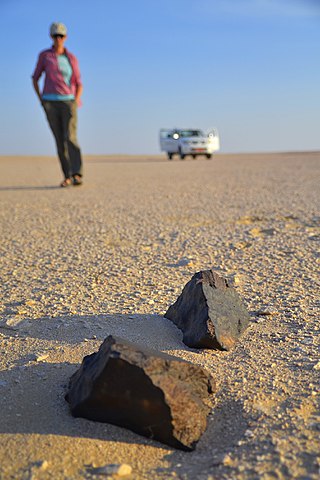
A meteorite find is a meteorite that was found by people, but whose fall was not observed. They may have been on Earth's surface for as many as thousands of years and therefore could have been subject to varying amounts of weathering.
Penouille is an iron meteorite found in 1984 in Canada.
Veliky Ustyug is a pseudometeorite that fell on July 3, 1290 in Kotovo village, near the town of Veliky Ustyug, Vologda Oblast, Russia. The fall was witnessed by local priests. The event was later described in the Life of Procopius the Righteous.
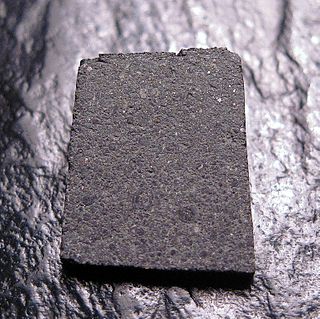
Moss is a carbonaceous chondrite meteorite that fell over the communities of Rygge and Moss in Østfold county, southeast southern Norway in the morning of midsummer day, July 14, 2006.

Acapulcoites are a group of the primitive achondrite class of stony meteorites.
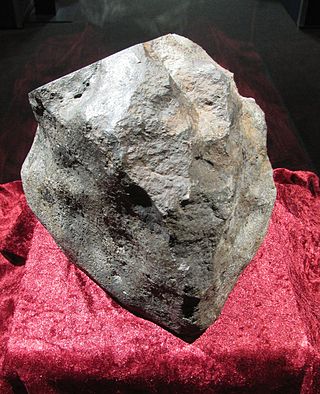
The Oldenburg meteorite fell 23 km from Oldenburg, Niedersachsen, Germany on 10 September 1930, one stone falling in Bissel, the other in Beverbruch. The mass of this meteorite is 16.57kg.
Zaisho is the name of a stony-iron pallasite meteorite whose fall in Japan in February 1898 was recorded by observers on the ground. Zaisho made landfall in the city of Kami, located in the prefecture of Kōchi on Shikoku Island. Zaisho weighs approximately 0.33kg (12oz) and exhibits a rare composition of primarily iron rich phosphoran olivine, and pyroxene. Zaisho also contains traces of stanfieldite, farringtonite, troilite, schreibersite, chromite, and mg-phosphate, albeit in smaller amounts. Notably, Zaisho is also one of two confirmed meteorite landings to take place on the island of Shikoku, and as of 2019 it remains one of only four known pallasite falls, along with Marjalahti, Mineo and Omolon. Currently, access to Zaisho is not available to the public as the main mass of the meteorite is being held in a private collection.
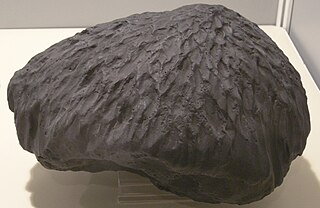
Baszkówka is an L5 ordinary chondrite meteorite which fell on 25 August 1994 in Baszkówka village, 23 km SSW of Warsaw. The fall occurred at around 4:00 pm. Several people heard a sonic boom, and one woman witnessed a movement on the surface of cultivated land 200 m away from her. A single specimen of a meteorite with radial regmaglypts was recovered immediately.